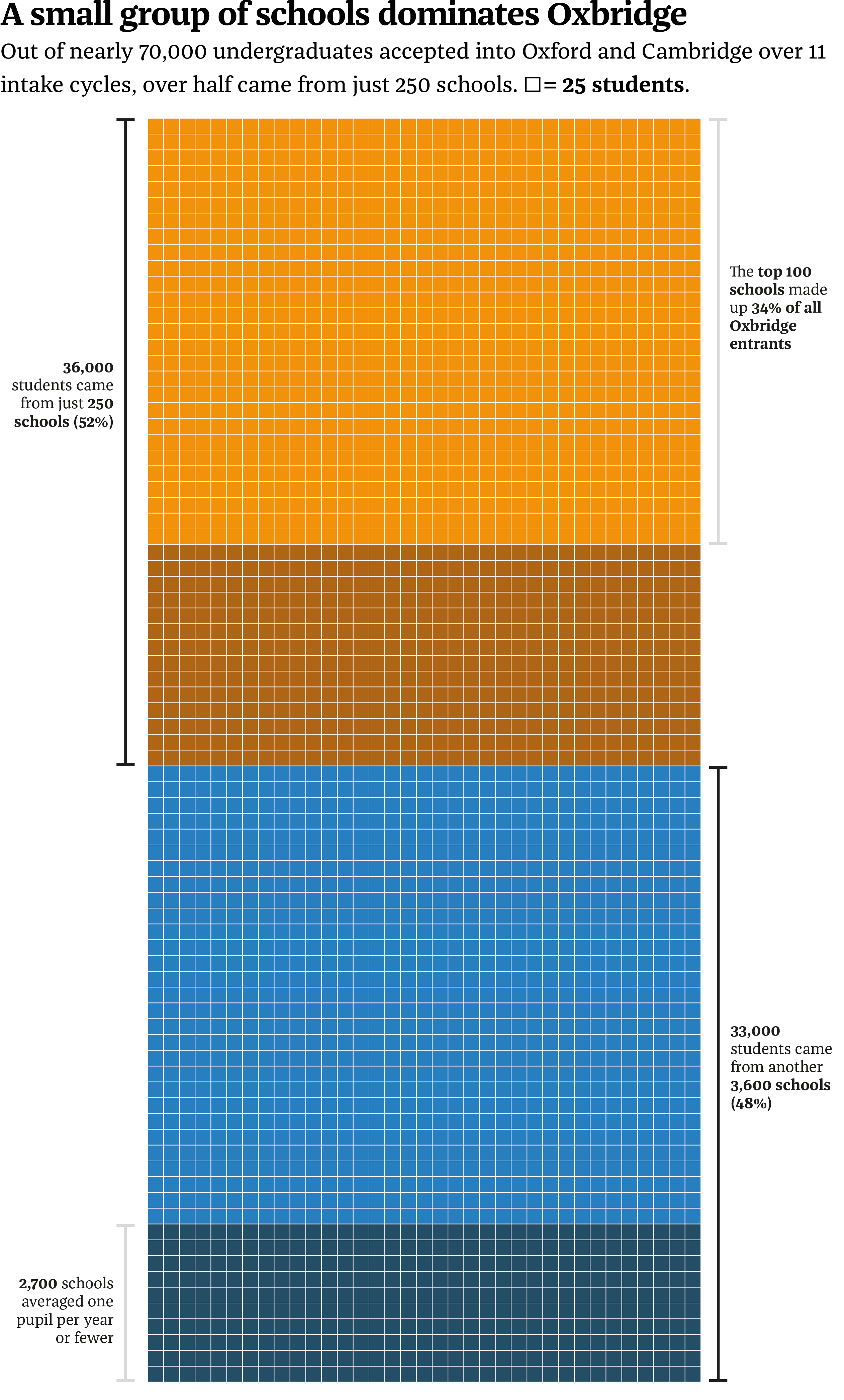Oxbridge admissions dominated by top schools
Over a third of students admitted to Oxford or Cambridge over 10 years were from just 100 schools

Oxbridge is dominated by a small group of elite schools, with over half the students accepted over a decade educated at just 250 institutions.
An investigation by Varsity, looking at 11 undergraduate intake cycles over the decade from 2006 to 2016, shows the huge proportion of students who come from a small number of schools.
It found that over a third of students came from the top 100 schools, which includes many of the country’s most expensive independent schools. Just under one in nine students came from a school that sent one pupil or fewer to Oxbridge per year on average.
Access is one of Oxbridge’s most thorny issues, with both Oxford and Cambridge – ranked last year as the two best universities in the world – spending millions of pounds per year on outreach efforts. Both universities have come under intense scrutiny for their disparities in acceptance rates, with one MP last year describing colleges as “fiefdoms of entrenched privilege.”
Today’s findings show that there remains a gulf between a top set of schools who send multiple students to Oxford or Cambridge every year, and thousands of other schools that send far fewer. They have strong implications for ‘access after admissions’, which has become a key focus for campaigners in recent years – it means that many Oxbridge undergraduates arrive with pre-built networks of school peers, while other students will be the only person from their school in their cohort.

Of the top five schools for overall intake, three – Westminster School, Eton College and St Paul’s School – are UK independent schools that charge day pupils over £20,000 a year. Eton and St Paul’s are all-male, while Westminster admits female students to its sixth form. Hills Road Sixth Form College, which is adjacent to Homerton college, is ranked third, with Raffles Junior College in Singapore placing fifth despite a below-average success rate. St Paul’s Girls’ School, which ranks sixth overall, has the most strikingly high success rate among the top schools: over 50% of its pupils who applied to Oxbridge over the cycles were accepted.

They also show the dramatic regional disparities in access, with students predominantly coming from London and the South-East. New geographic analysis shows that intake number do not show the full picture for access, however: in terms of success rates, the greatest divide is not between regions, but between metropolitan and rural areas.
To counteract the overrepresentation of certain areas, Cambridge runs an Area Links Scheme, in which colleges are assigned regions in which to undertake access work. A separate report by Varsity today shows the disparities in the system, including the finding that access work in London is carried out by 17 colleges across 33 areas, whereas the entirety of Wales is covered by just two colleges.
Cambridge has long been caught in a difficult bind between maintaining its highly selective applications process, which it says is vital to maintaining academic standards, and improving the diversity of its student body. In recent years, the colleges rejected a proposal to reduce grade offers made to students from disadvantaged backgrounds.
An analysis by the Higher Education Policy Institute last month found that Cambridge was the “most unequal” university for proportionately representing students from areas of varying higher education participation in its October 2016 intake.
CUSU president Daisy Eyre said that the findings showed Cambridge needs to take steps to improve its access figures, saying “the Universities of Oxford and Cambridge are a key part of the reproduction of privilege in the UK and beyond”.
“In my experience, the admissions process at Cambridge sees itself as meritocratic, but the fact that 100 schools make up a third of our undergraduate admissions shows quite clearly that this is not the case,” Eyre said. “Cambridge admissions reproduce the educational inequalities in wider society and the University needs to take responsibility for this.
“At present, Cambridge admissions efforts are stagnating and they need to take active steps towards a more diverse admissions process.”
“I am, however, relatively optimistic about the steps the University is looking into to address this,” she added.
- Update Friday 27th April: One of the graphics in this piece was corrected to fix a mistake.
 Comment / Cambridge’s tourism risks commodifying students18 April 2025
Comment / Cambridge’s tourism risks commodifying students18 April 2025 News / Cambridge student numbers fall amid nationwide decline14 April 2025
News / Cambridge student numbers fall amid nationwide decline14 April 2025 News / Greenwich House occupiers miss deadline to respond to University legal action15 April 2025
News / Greenwich House occupiers miss deadline to respond to University legal action15 April 2025 Comment / The Cambridge workload prioritises quantity over quality 16 April 2025
Comment / The Cambridge workload prioritises quantity over quality 16 April 2025 News / Varsity ChatGPT survey17 April 2025
News / Varsity ChatGPT survey17 April 2025






